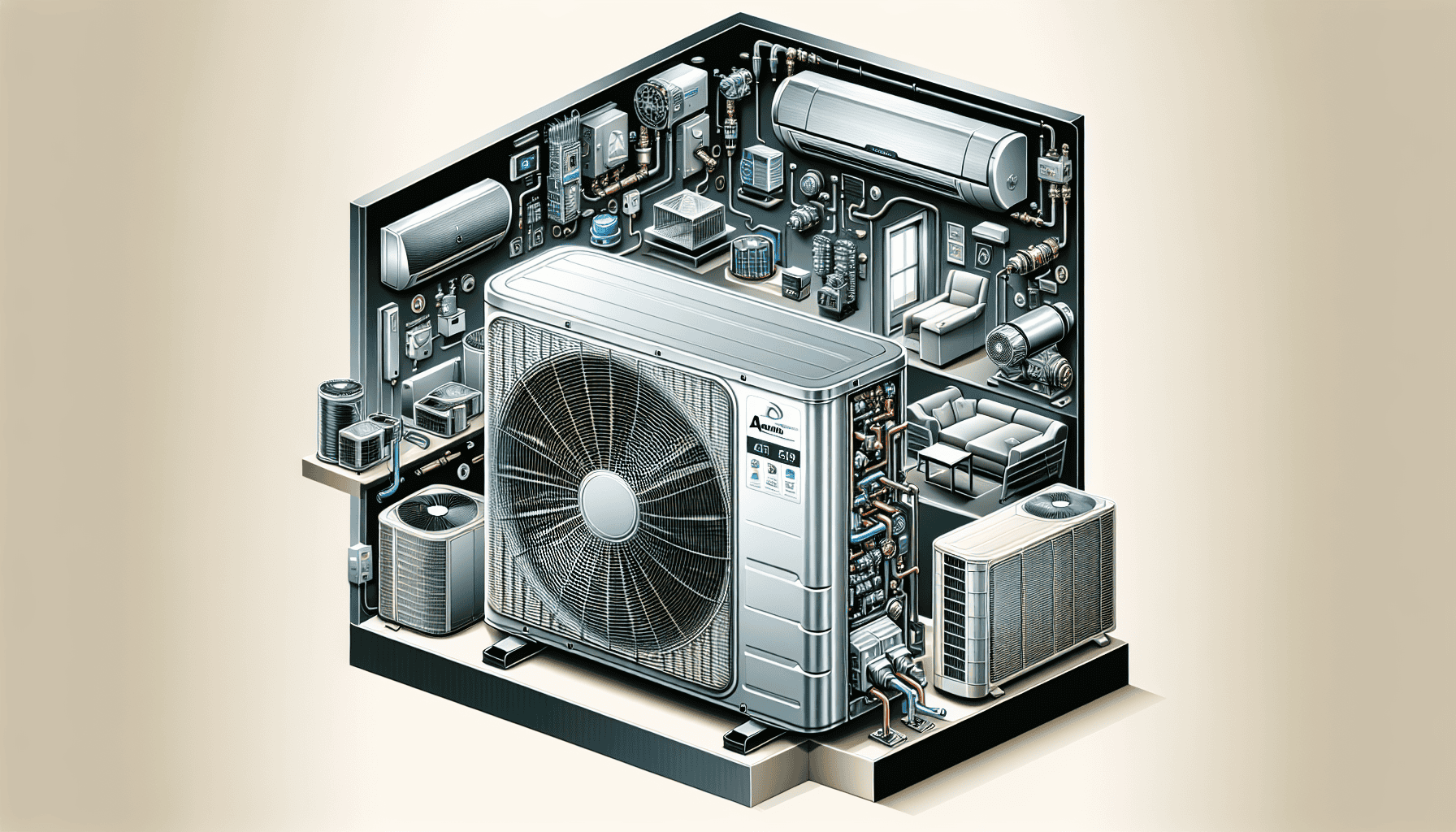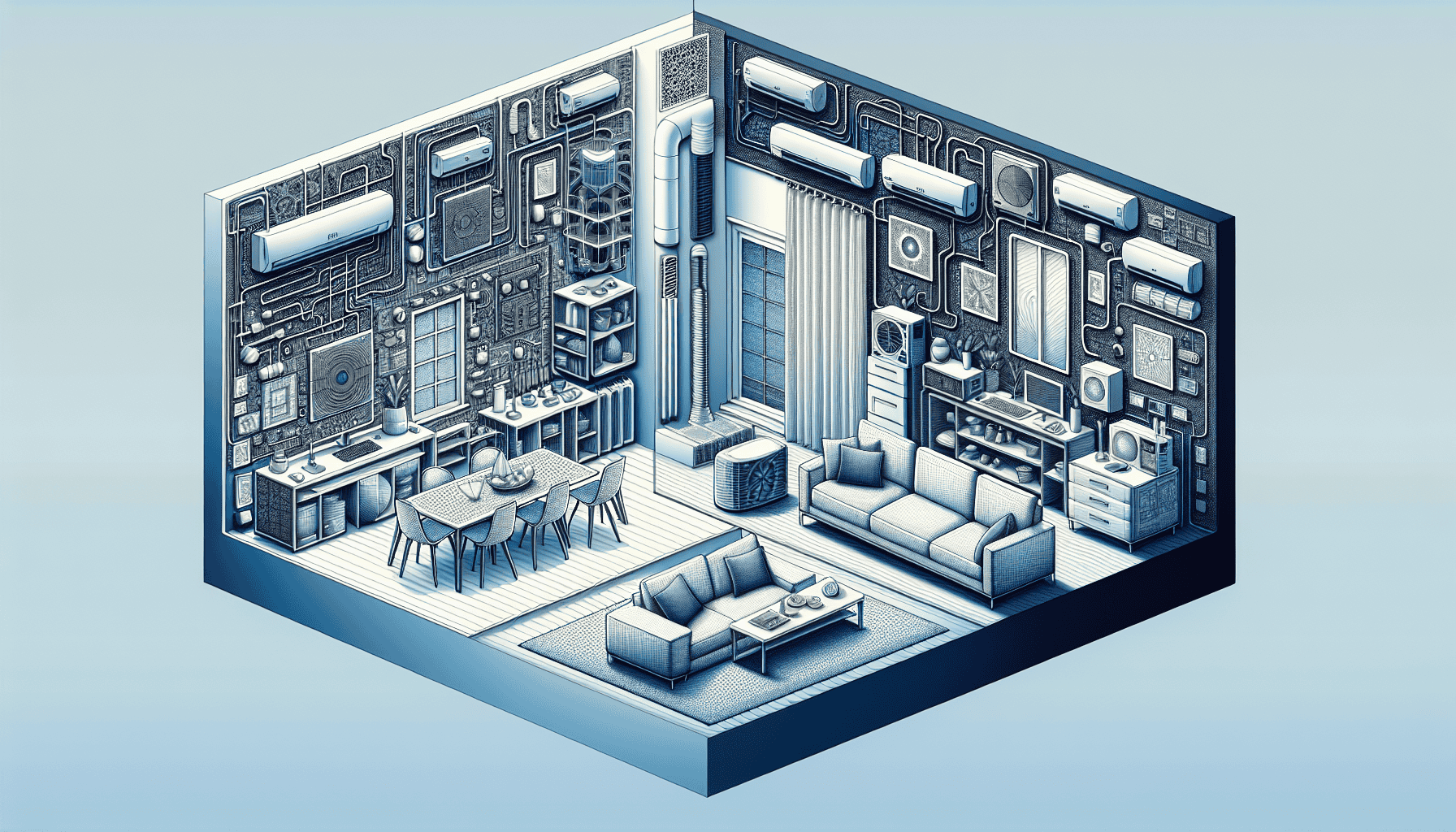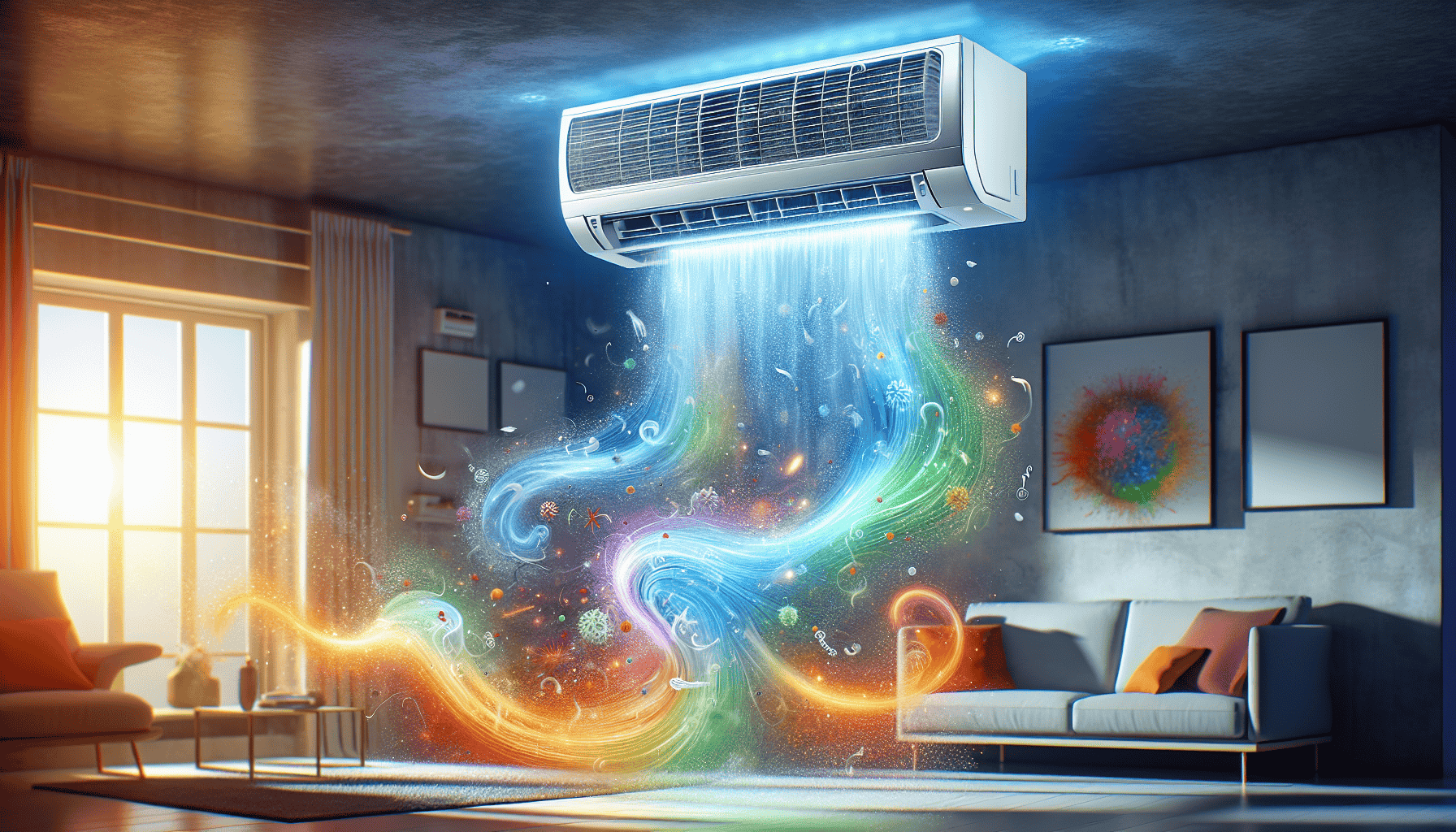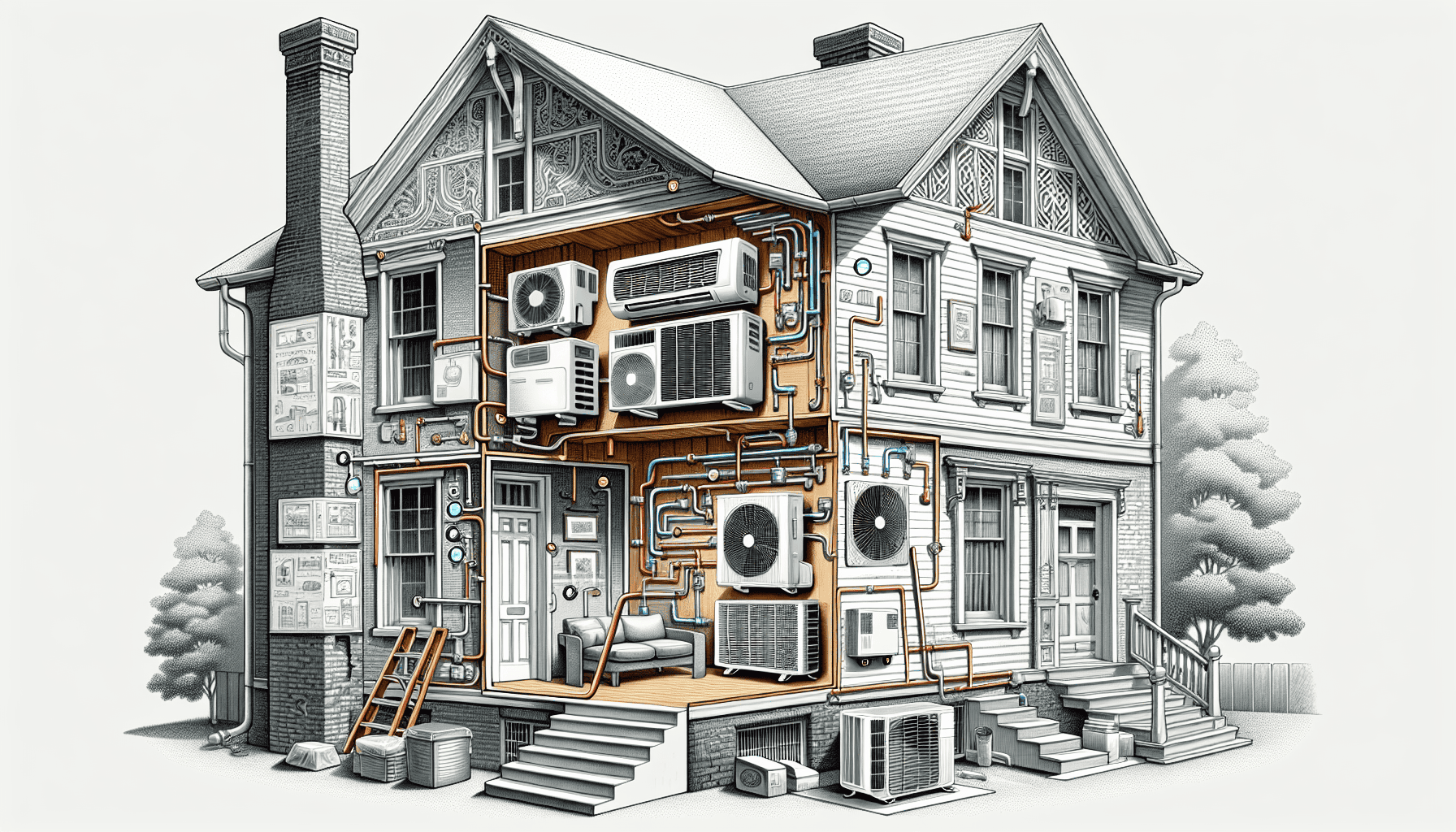Ductless air conditioning, also known as mini-split systems, provides a cooling and heating solution for homes that lack ductwork. These installations feature an external compressor linked to one or several indoor units that manage the climate in designated areas or rooms. This type of air conditioning enables precise temperature regulation within specific zones and is perfectly suited for properties without pre-installed ducts as well as those looking to achieve individual room comfort control. We will delve into the functionality of these systems along with their advantages and possible disadvantages throughout this discussion.
What Is Ductless Air Conditioning?
Exploring the world of ductless air conditioning reveals an ingenious and efficient method for managing indoor climate. A ductless mini split system primarily comprises two units: one situated outdoors which includes the compressor and condenser, and at least one indoor unit that comes with an evaporator and blower. This combination efficiently channels heated or cooled air straight to targeted areas without relying on a complex network of ducts as seen in conventional heating, ventilation, and air conditioning systems.
Known widely as mini split systems, they are adept at providing precise temperature control within distinct spaces or zones in your residence, offering unmatched regulation over domestic comfort levels. Each aesthetically pleasing interior component—referred to as an air handler—is carefully placed within its environment so it integrates well visually while silently supplying conditioned air to ensure optimum ease using a mini split system for cooling or heating purposes.
How Does Ductless Air Conditioning Work?
The ingenious design of ductless mini split systems employs a conduit that connects the indoor air handlers to the outdoor compressor, carrying both electrical and refrigerant lines. This enables the system to pull heat out from inside your home and expel it outside through an air conditioner unit, which cools your environment. When temperatures drop, this system can reverse its function to warm up your space, showcasing its dynamic utility.
Ductless mini splits harness inverter technology for enhanced efficiency by modulating compressor speeds according to temperature demands. This smart adjustment results in maintaining steady room temperatures without suffering from energy loss due to continuous on-off cycling common with conventional air conditioners. Ultimately, this leads to proficient climate control within your abode that is not only responsive but also conserves energy remarkably well.
Types of Ductless Mini Split Systems
Various forms to cater to a range of architectural styles and individual tastes are available in ductless mini split systems. These systems mainly come as single-zone or multi-zone setups, each crafted for particular needs. Depending on whether the aim is climate control for one room or several spaces, there exists a customizable ductless mini solution that can provide the desired comfort.
When it comes to installation choices for these units, you’ll find wall-mounted options along with floor-mounted ones, ceiling cassettes, and concealed duct configurations. Each of these presents distinct benefits and fits different space constraints.
Single-Zone Systems
A single-zone ductless system excels in its simplicity, consisting of just one outdoor compressor and an indoor unit. It’s the ideal choice for precise temperature control in individual spaces such as home offices, sunrooms, or master suites where you might want a different climate from the rest of your residence. These systems offer a simple yet effective means to regulate temperatures in specific areas without entangling themselves with more complex networks.
The installation process of these systems is notably minimalistic and requires only a small hole to be made within the wall that facilitates connection between indoor and outdoor units. This ensures there is minimal disruption to both the structural integrity and appearance of your dwelling, allowing for easy incorporation of comfort into any room without significant alteration or inconvenience.
Multi-Zone Systems
Ductless air conditioners with multi-zone capabilities provide the versatility needed for cooling and heating different spaces to varying degrees of comfort. An outdoor unit efficiently operates several indoor units, which allows each zone to have its own temperature control. As a result, you can maintain a warm environment in your nursery while ensuring that your home gym is pleasantly cool, all thanks to one central compressor managing these diverse areas.
Key features of these ductless systems include:
- The option to connect up to five separate indoor units
- The potential for scaling up, making them an ideal option for expansive homes or those progressively being remodeled
- Compatibility with intelligent controllers that facilitate efficient zonal management of your ductless air conditioning system for optimal convenience and energy efficiency.
Benefits of Ductless Air Conditioning
Ductless air conditioning is not solely focused on providing cool air. It offers a wide array of advantages, from boosting the comfort and well-being within your living spaces to promoting energy efficiency, simplifying installation processes, and significantly enhancing the quality of indoor air—all pivotal factors in adopting this contemporary method for managing temperatures.
Energy Efficiency
Ductless mini split systems are celebrated for their remarkable energy saving capabilities. These units significantly curb energy consumption in air conditioning—by over 30%—due to the absence of ductwork, which typically leads to energy loss. These systems’ inverter technology plays a crucial role in enhancing energy efficiency. It modifies compressor speeds continuously to keep temperatures steady, circumventing the inefficient on-off cycling characteristic of traditional air conditioners.
The heightened efficiency afforded by these mini split systems can lead to considerable cost savings on household utility expenditures—with reductions between 30-40% when measured against standard forced-air installations. The zoning function that is integral to ductless mini splits allows for heating or cooling only occupied areas, thereby reducing unnecessary energy use further. Combining these substantial savings with potential tax incentives and rebates underscores why investing in a ductless mini system is an economically prudent decision for long-term financial benefit.
Easy Installation
Fitting a ductless system is significantly less disruptive than installing conventional HVAC systems with extensive ductwork. The simple requirement of just one small hole in the wall for connecting the indoor and outdoor units means that installation can frequently be wrapped up within a day, making it an ideal choice especially for older constructions where putting in standard ductwork might be expensive and potentially harmful to the building.
Ductless systems come with added flexibility regarding placement: indoor units may be affixed to either walls or ceilings, while the corresponding outdoor unit can be positioned as far as 50 feet away. This versatility ensures that regardless of your home’s layout, installation will cause minimal interruption to your domestic environment and allows you to preserve your home’s visual appeal.
Improved Indoor Air Quality
Indoor air can often contain pollutants, yet ductless systems are designed with advanced multi-stage filtration that tackles this problem effectively. Such filtration drastically diminishes the levels of:
- dust
- bacteria
- pollen
- allergens
- other detrimental particulates
As a result, it creates an environment that is more conducive to health. For individuals who have heightened sensitivity to air quality, some ductless systems come equipped with superior HEPA filters capable of eliminating upallergichlergens to 99,97% of particles suspended in the air, ensuring exceptionally pure indoor atmosphere.
Choosing a ductless system confers multiple advantages like:
- Precise control over temperature
- Superior filtration technology
- Active management for better indoor air quality
- Enhanced comfort and well-being for those spending extended periods indoors
It represents not just an investment in your home’s comfort, but also ensures greater peace of mind regarding one’s health and mood.
Drawbacks of Ductless Air Conditioning
While ductless air conditioning offers many benefits, it’s important to acknowledge certain drawbacks. These include a more expensive upfront investment, considerations regarding the system’s appearance in your space, and the need for consistent maintenance—all of which should be balanced against the advantages when contemplating these air conditioning systems.
Higher Initial Cost
The initial financial commitment to install a ductless system can be daunting, as the costs for professional installation and accompanying parts often surpass those associated with conventional HVAC units. Yet, it’s important to consider not just this immediate cost, but also the long-term advantages that may arise.
Ductless systems boast energy efficiency that could compensate for their higher upfront costs through reduced expenses in operation over its lifespan. Tax incentives and rebates might be obtainable to alleviate some of these initial expenditures, rendering ductsoftless systems an economically sound choice as time progresses.
Aesthetic Considerations
Another aspect to consider with ductless systems is their visual presence. While manufacturers have improved designs to be more streamlined and less intrusive, it’s undeniable that the indoor units will still be visible in living spaces. Homeowners may feel that wall or ceiling-mounted units do not align well with their design aesthetic.
When a home necessitates multiple indoor units to cover different zones, this issue becomes even more pronounced. Unlike traditional HVAC systems which hide ducts behind walls, the components of a ductless system stand out as noticeable elements within a room’s interior scheme. Despite offering significant advantages, homeowners must carefully evaluate the visual impact when contemplating installing such a system in their residences.
Regular Maintenance
Keeping up with a ductless system demands consistent dedication. Routine activities, including the cleaning or replacement of air filters, verifying refrigerant charge levels, and examining the electrical connections, are essential to maintain peak efficiency and extend its life span. While homeowners can take on some upkeep responsibilities such as clearing debris from around the outdoor unit and keeping air filters clean, more complex services should be left to a qualified technician.
The value of expert maintenance is critical. Improper handling of delicate parts within your ductless system may not only impede its operation, but may also lead to invalidating your warranty. Incorporating regular checks by skilled professionals into your care routine will ensure that your equipment operates effectively while possibly sidestepping expensive repairs down the line.
Is Ductless Air Conditioning Right for Your Home?
When determining if a ductless air conditioning system is the right fit for your residence, you must thoughtfully evaluate multiple aspects such as whether current ductwork exists, your home’s dimensions, and financial implications.
Homes Without Existing Ductwork
Ductless air conditioning systems revolutionize climate control in structures lacking built-in ducts, enabling independent temperature management for different zones without necessitating a complex duct network. This is particularly beneficial for:
- Older or historic dwellings where adding traditional air ducts could be intrusive and possibly compromise the architectural authenticity.
- Compact spaces like small apartments or condos that cannot accommodate conventional ventilation channels.
- House extensions or remodels where linking to existing ductwork can prove too expensive or unfeasible.
These innovative cooling and heating solutions afford tremendous flexibility, rendering the various components of a ductless HVAC system—such as the individualized units of both a generic type and specifically those labeled as “ductless ac”—perfectly suited to these environments.
Diverse architectural styles with unique design challenges are readily accommodated by such systems. Homes featuring non-standard floor plans or bearing restrictive structural elements can maintain their aesthetic appeal while benefiting from contemporary comfort provided by this modern air conditioning technology without altering their fundamental character.
Small vs. Large Homes
Ductless air conditioning systems offer a flexible solution for temperature control in homes of all sizes, with the caveat that their effectiveness hinges on selecting the appropriate size. For instance, to efficiently cool a space ranging from 150 to 250 square feet, one would need an air conditioning unit rated at 6,000 BTUs. Conversely, areas exceeding those dimensions might necessitate an installation exceeding 18,000 BTUs.
For compact dwellings, it may be sufficient to install just one or several units placed tactically throughout the residence. In contrast, expansive abodes are likely better served by incorporating a multi-zone ductless air system capable of dispatching heating and cooling selectively across different regions within the home. By ensuring each ductless air conditioner is properly scaled for its intended area not only assures thermal comfort, but also curtails superfluous energy consumption while promoting peak efficiency in operation.
Cost Considerations
Installing a ductless air conditioning system involves various financial considerations, with the initial expenditure often reaching around $3,000. This figure might be supplemented by additional costs for necessary home upgrades like electrical panel enhancement or installing new electric lines throughout your property. It’s important to take into account these potential extra expenses beyond just the listed price of the ductless air system.
The initial outlay should not be viewed in isolation though. It’s important to consider long-term factors such as energy cost savings, eligibility for tax credits or rebates, and the advantages that come from having an adequately sized and professionally installed ductless air conditioning unit. With proper installation and maintenance, a homeowner can benefit from years of efficient temperature regulation provided by their ductless air conditioning solution – making it an investment worth evaluating carefully.
Navigating Ductless HVAC Systems
As we conclude our exploration of ductless air conditioning technology, it becomes evident that these systems bring an array of advantages to contemporary homeowners. Ductless air conditioners are not only energy efficient and environmentally beneficial, but also offer simple installation procedures alongside enhancements in the quality of indoor air. One must take into account the initial expenses, visual impact on home aesthetics, and ongoing maintenance requirements associated with this type of heating and cooling solution.
If you’re undertaking a renovation project in an old property, extending your residential space or simply looking for a more effective method to manage the climate inside your home. Ductless air conditioning systems deserve thorough consideration. Offering customized temperature control that aligns precisely with individual preferences, these units mark a progressive leap towards achieving heightened comfort within our living spaces. At Quick Air, we offer customized ductless HVAC system and ductless mini split system installations based on your specific needs. Our professional heating and cooling contractors are experienced and equipped to help you with your air conditioning needs. Contact us today for a free consultation.
Frequently Asked Questions
What is the main difference between ductless air conditioning and traditional central air systems?
The main difference between ductless air conditioning and traditional central air systems is that ductless systems do not require ducts to distribute air, offering more precise temperature control and energy efficiency.
Are ductless air conditioning systems energy efficient?
Indeed, ductless air conditioning systems offer a notable advantage in terms of energy efficiency. By eradicating the energy losses typical of ductwork and employing inverter technology to sustain even temperatures, these ductless air systems can achieve substantial energy reductions—between 30-40% when measured against conventional forced-air units.
Can ductless air conditioners provide both heating and cooling?
Indeed, numerous ductless air conditioners are capable of delivering both heating and cooling functionality, rendering them a flexible choice for maintaining comfort throughout the year without the need for extra apparatus.
How often do ductless air conditioning systems require maintenance?
To ensure optimal performance, ductless air conditioning units need to be maintained regularly. This includes the tasks of cleaning or swapping out air filters and monitoring refrigerant levels. While homeowners can perform some of these maintenance activities, certain procedures should be carried out by a certified technician.
What should I consider when deciding if a ductless air conditioning system is right for my home?
When determining whether a ductless air conditioning system suits your home, you should evaluate elements like the presence or absence of current ductwork, the size of your home, installation expenses, available rebates and incentives, and potential savings in energy over time.
Ductless air systems are perfectly suited for homes lacking pre-installed ducts and can efficiently serve both modestly sized areas and expansive spaces.






